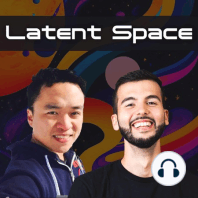70 min listen

The State of Silicon and the GPU Poors - with Dylan Patel of SemiAnalysis
The State of Silicon and the GPU Poors - with Dylan Patel of SemiAnalysis
ratings:
Length:
53 minutes
Released:
Nov 17, 2023
Format:
Podcast episode
Description
This episode came together at ~4 hrs notice since Dylan had just landed in SF and we had to setup quickly; you might notice some small audio issues in some segments, we apologize. We’re currently building our own podcast studio for 2024! ? We’re ramping up our presence on Twitter and YouTube if you’d like to support us.Note: 17k people joined our emergency pod on Sam Altman’s ouster today.If Charles Dickens was alive in 2024, A Tale of Two Cities might be the divide between the “GPU poor” and the “GPU rich”.We mentioned these terms in some of our previous episodes; they were originally coined by of in his “Gemini Eats the World” post, put on blast by Sam Altman. SemiAnalysis are one of the most in depth research and consulting firms in the semis world, and have a unique insight into the design, production, and supply chain of GPUs based on their ground presence in Asia. In this episode we break down the State of Silicon: when are more GPUs coming? Are there real GPU alternatives on the way? Should Microsoft buy AMD chips just to scare Jensen? Is there a “GPU poor is beautiful” manifesto?The supply wave is comingThe GPU shortage is the talk of the town in the Bay Area, but next year looks a lot better in terms of AI accelerating capacity: * NVIDIA is forecasted to sell over 3 million GPUs next year, about 3x their 2023 sales of about 1 million H100s.* AMD is forecasting $2B of sales for their new MI300X datacenter GPU. They are also indirectly getting a boost from the work that companies like Modular and tiny are doing in making it easier to actually use these chips (will ROCm ever catch up?)* Google’s TPUv5 supply is going to increase rapidly going into 2024* Microsoft just announced Maia 100, a new AI accelerator built “with feedback” from OpenAI. In the episode we dove deeper into what this means for each of these companies and the GPU consumers, but the TLDR (sadly) is that capacity increases but FLOPS requirements to train the next generation of models will eclipse the one of previous ones. GPT-3 was 4,000x more FLOPS than GPT-2. Dylan estimates GPT-4 was trained on 20,000 A100s for ~$500M all-in; how much will OpenAI spend to train GPT-5? How many GPUs will need to go brrr? In the meantime, the amount of companies looking for GPUs has increased, with Meta rising as one of the de-facto top 3 AI labs in terms of capacity. The pressure to acquire more chips will not ease in 2024. We also talked about some of the companies trying to displace traditional GPU architectures: MatX, Lemurian Labs, Cerebras, etc. The different variables they are fighting on are size of SRAM vs HBM, focusing on memory bandwidth vs memory size, different math representation for kernels, etc, and how the key to this market is whether or not the transformer architecture will still be the #1 in the future.Surviving in the GPU Poor laneA lot of the smaller companies (when compared to $1T+ giants, it’s all relative) are trying hard to fight against the GPU rich, but they can’t quite offer the same scale: * HuggingFace is trying to launch a training cluster as a service, but it seems to just be a software wrapper around NVIDIA’s GDX Cloud, as they don’t actually own that much GPU supply. The max option for GPUs to use is 1,000 in their form.* Databricks’ “GPU-enabled clusters” run on AWS, and the largest one listed there is only powered by 8 NVIDIA A10Gs. The Mosaic team is also doing research on running on AMD cards with some promising results, but they seem to be pushing up to just 128 cards, which isn’t much.* Together actually has 4,424 H100s live in production, which is quite sizable but still nothing compared to the 100,000 that Meta is putting online. Take LLaMA2 as an example; the 70B model was trained on 2T tokens. Using the highest accelerator count on HuggingFace it’d take ~43 days to train the model from scratch and it’d cost ~$2M. That doesn’t include all the data and prep work. In the meantime, Zuck is probably burning tens of thousands
Released:
Nov 17, 2023
Format:
Podcast episode
Titles in the series (67)
Training a SOTA Code LLM in 1 week and Quantifying the Vibes — with Reza Shabani of Replit by Latent Space: The AI Engineer Podcast — Practitioners talking LLMs, CodeGen, Agents, Multimodality, AI UX, GPU Infra and all things Software 3.0